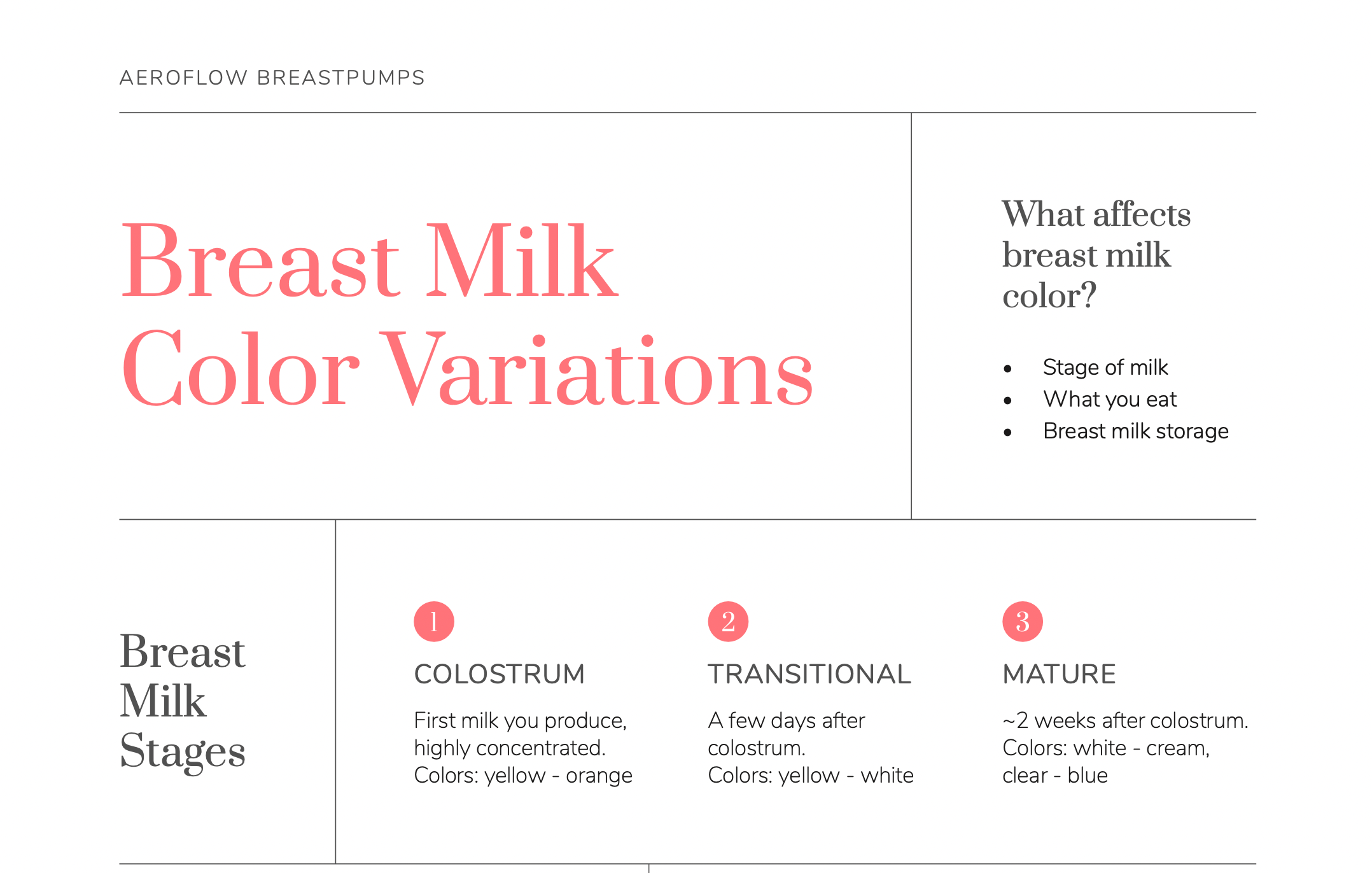Your body is providing your baby with the unique milk they require for their best development. It’s reassuring, right? Until a surprise like strawberry-colored milk or green and blue tinges appear during a pumping session. What in the world?
Your milk is a multi-faceted reflection of your life, so let’s learn to identify what your breastmilk is trying to tell you.
What Are The Different Colors of Breast Milk?
Click here to view or print the full-size Breast Milk Color Variations guide.


YELLOW/ORANGE:
- Yellow breast milk is common for your first milk, colostrum. Colostrum contains many of the antibodies needed to protect newborns against disease. Colostrum can vary from clear to golden yellow and is the perfect first food for your baby.
- Concentrated levels of white blood cells, leukocytes, and Immunoglobulin A that appear when the body is processing infections can also cause this rich, buttery appearance. Look at you building your baby a strong immune system!
- Strongly pigmented, beta-carotene-rich foods, such as turmeric, sweet potatoes, or carrots, can also give a richer amber tone to breast milk, and that’s not a bad thing! Keep eating these healthy foods.1
- A yellow or orange color is rarely an indicator of anything that needs medical assistance.
WHITE:
- It is often thought that how “white” milk appears has to do with its purity or fat/protein content, which is not necessarily true. In fact, the only way to accurately assess fat and protein content in breast milk is by examining it in a lab.
- White milk is most often a sign of lactation production reaching full maturity. Breast milk changes from colostrum to transitional milk and then to mature milk in the first two weeks after birth. If you’re seeing white milk, you’ve transitioned to a mature milk supply. Nothing to be concerned about here.
CLEAR/BLUE:
- Lactose overload is associated with the release of milk that has less fat and protein, which often causes breast milk to appear clear or translucent blue. 2 This can occur when the breasts haven’t been drained for a longer period than usual, based on the norm for you and your baby.
- While a high level of lactose in your breast milk is no cause for concern, it can cause your baby to be gassy, fussy, and hard to settle. It can even create frothy or green stools in your baby’s diaper. If your little one experiences these symptoms, check in with a lactation specialist or your baby’s healthcare provider.
- If your milk is coming out clear, try gentle but dynamic breast massage, and moderate warm compresses to increase circulation. This will help to increase the fat content in your expressed breastmilk and balance out the lactose overload. Try a breast massage before feeding or pumping and see if it makes a difference.
GREEN:
- If you are eating a diet full of cruciferous and leafy greens or algae-seaweed supplements, your breast milk may take on a green appearance.3 That's okay because these foods are full of vitamins and nutrients that are good for you and your baby.
- Remember, when you consume the green foods mentioned above, your baby’s stool may turn green as well.
- Though most often caused by diet, green breast milk can occasionally be a sign of infection. If you or the baby feel sick or have been sick recently with no changes in diet, it's always worth getting checked out to be sure your breastfeeding journey continues smoothly.
RED/PINK/BROWN:
- Typically not urgent, but often uncomfortable, breast milk with a pink or reddish tinge may indicate blood caused by broken capillaries or nipple damage. At times it can be a sign of mastitis, a breast infection. More rarely, breast cancer can also be the cause of blood in breast milk.
- Foods like beets, cherries, and pomegranate (the most common and potent suspect) may cause breast milk to turn pink. Anything with a strong deep red or burgundy color pigment can lend its color to your breast milk.
- Rusty pipe syndrome, which causes a brownish color to colostrum, is due to old blood in the milk ducts. This condition is sometimes seen in the first few days of breastfeeding. The small amount of blood is not harmful to your baby. It is not a barrier to breastfeeding and should clear up on its own.4
- If you are experiencing pain, discomfort, or concern of any sort about the sensations you feel while breastfeeding or pumping, or the appearance of otherwise healthy milk seeming to have blood in it, it’s probably time to consult a healthcare professional. Your milk is generally safe for the baby to continue breastfeeding until otherwise instructed by your healthcare provider.
BLACK:
- This is one of the most unusual and rare colors for breast milk. Unlike many of the other color variations mentioned above, when you have black breast milk, you should reach out to your healthcare provider.
- Very dark breast milk is often a sign of prescribed medicine incompatibility, or possibly other more urgent health concerns. Minocin or minocycline, a type of antibiotic, is a possible culprit.5
Conclusion
A good general rule is “If it can change the color of your urine, your tongue, or your clothes, it can probably change the color of your milk.”
If you find that your breast milk has taken on a new hue, consider taking note of any foods or drinks with similar colors or tints. These could include beets, pomegranates, green vegetables, or even food dyes. Detail the time you ate or drank the colorful food/drink, and the amount you consumed, if possible.
Ask yourself:
- Could the color change be because of your diet?
- Were you and/or your baby around anyone sick recently? Are either of you experiencing any symptoms?
Eating foods the color of the rainbow is a marvelous way to be sure your body has the nutrition you need in your postpartum life. Knowing that some bright fruits and vegetables can cause color changes in your milk will ease your mind the next time it happens. By paying close attention to any symptoms you or your baby are experiencing, you'll be better equipped to decide when to see your healthcare provider.
What If I Have Questions?
If you are interested in learning more about why your breastmilk changed color, you can schedule a one-on-one appointment with an Aeroflow lactation consultant here.









